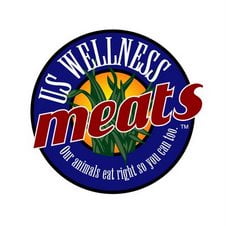 If you've been part of the Real Food movement for a while now, you already know about the huge health benefits of grassfed meats, but you may not have figured out yet how exactly to fit it into your budget. First, keep in mind that while there is an extra expense, it's worth it. You get what you pay for and you can pay now or pay later, just as you've heard it said… As in, pay more for real food now or pay the doctor later. But today John from U.S. Wellness Meats shares seven ways to save money on this real and life-giving food, and he also shares more about how he got his business started. (This is my favorite place to buy meat online if you don't have a good local source. Use code KOP for a discount!)
If you've been part of the Real Food movement for a while now, you already know about the huge health benefits of grassfed meats, but you may not have figured out yet how exactly to fit it into your budget. First, keep in mind that while there is an extra expense, it's worth it. You get what you pay for and you can pay now or pay later, just as you've heard it said… As in, pay more for real food now or pay the doctor later. But today John from U.S. Wellness Meats shares seven ways to save money on this real and life-giving food, and he also shares more about how he got his business started. (This is my favorite place to buy meat online if you don't have a good local source. Use code KOP for a discount!)
Q & A with John from U.S. Wellness Meats:
- Did you grow up farming?
Yes, 5th generation in NE Missouri. Great Great grandparents settled into Lewis Co. in 1852.
- How did you first learn the importance of pastured/grass fed meats and then get started in business?
It was a combination of discovering Dr. Michael Pariza's CLA research at the Univ. of Wisconsin, reading Holistic Resource Management by Allan Savory and subsequently bringing in a registered educator into Lewis Co. in 1993, and Univ of Missouri's lead in managed grazing. This planted the seeds for grass-fed beef production but none of us had a clue in in the mid 90's where the vision would lead.
- What's your own personal favorite cut of meat or other product you sell?
There is no personal favorite. I simply enjoy the flavor of grass-fed fat in a variety of cuts. From a value and flavor stand point, top sirloin, flatiron and burger are hard to beat.
- Can you tell us about the other farming friends who provide meat for U. S. Wellness Meats?
We are simply cut from the same cloth. All have a passion for being part of a grass-fed industry and enjoy doing what is good for the soil, plant community, rural community and the end consumer.
- I'm curious where you're at with whole WAPF thing, do you mainly eat pastured meats, or do you also take FCLO, eat plenty of butter, drink raw milk, etc.?
Both of my grandfathers lived well up into their 90's and one two weeks shy of a 100 and they were WAP diet junkies. Neither had heart disease, diabetes or cancer. Yes, I believe the WAP diet is top shelf and am in better heath now than when I started this journey in the mid 1990's. Growing up, I drank raw milk, consumed raw butter and raw cottage cheese from the family dairy cow and tended to a very large garden that pretty much fed our family growing up. Went off to Iowa State in the Fall of 1970 and gained ten pounds in the first semester eating conventional food for the first time. Now I know why.
- The biggest complaint about grass-fed meat is how expensive it is. Can you give us ideas for saving money while eating well, too?
Here are seven money-saving tips (note that these are from several years ago and are likely outdated, just check with USWM for current deals):
- Flat iron steaks and sirloin steaks are a great buy on a per pound basis. 11.25 to 12.50 per pound before discounts. Essentially 40% off compared to strips and ribeyes and you give up very little quality.
- Buy ribeye and striploin primals and cut those costs 40% by cutting your own steaks.
- Read our newsletter and pick up red letter 15% discount code every other week.
- Combine order with friends to get the $25 off for each 40 lbs. ordered.
- Buy the inside round primal and back rib primal for 7.13 and 4.38/lb respectively before discounts.
- Get 50 lbs. of 75% burger to your door for 4.94/lb. which is much cheaper than most grass-fed in grocery stores. (75% burger contains double the CLA and omega 3 as the 87% product. You can split with a friend if storage is an issue.)
- Call our office and we can show you the value deals.
Thanks John! If you have more money-saving tips to share with us, we can't wait to hear from you in the comments. 🙂
My friends at U.S. Wellness Meats sponsored my trip to the Wise Traditions conference! You may want to check out my small print stuff: privacy policy, copyright, disclaimers, terms & conditions.


Robin says
good to know about the coupon code, I don’t remember seeing that! Will go look it up now…:-)
Robin says
Hi Kelly-
I have had it in mind to purchase their large (I believe 5-gallon?) pail of tallow for a while now but haven’t actually ordered any yet. However, I was just on their website today, and the only item listed for tallow is an approximately 1-pound (small) container for just under $10. Any idea what happened to the larger pail (I believe it sold for $90-$100 or so?). I’m just curious as to how much actually comes in that smaller container, doesn’t look like much…
KitchenKop says
They expect that to be back in stock anytime (they’re having trouble with their processor), so if you can be patient, you can still use the coupon code from the last post on USWM (announcing giveaway winner) to order that if you mention my posts. 🙂
mina says
Kelly, have you seen this?
https://gaia-health.com/gaia-blog/2011-11-12/fake-meat-is-coming-fresh-from-the-lab/
KitchenKop says
No, I haven’t, heavy sigh…
Stanley Fishman says
I can testify to the excellence of US Wellness meats. John has done a lot to enrich the soil on his farm through natural methods, and has greatly increased the density and quality of his forage. Great grass means great meat. I have been eating John’s meat for five years, and I still order it regularly. I have to mention the grassfed liverwurst, which is one of the healthiest sausages you can buy, containing, grassfed liver, heart and kidney. In fact, I use this sausage as the base of a number of recipes in my first cookbook, Tender Grassfed Meat.
Sue says
We buy a side of beef each year also. We paid $3.90/pound hanging weight, so I’m guessing the finished price is $5 or $6/lb. Most of it is ground beef – so I’m looking for new ways to use it. So far, the family likes chili, tacos, and something we call “beefarino” – which is ground beef, tomato sauce and penne. (The name came from a Seinfeld episode.) Anyway, aside from burgers, I’m looking for additional recipes that are dairy-optional (my daughter doesn’t each cheese). I really like buying beef this way because we use the whole animal – we don’t just cherry-pick the good parts and leave the rest. I usually use all the braising cuts over the winter and save the steaks for the spring and summer. Plus I get soup bones, dog bones. Suet was available, but we don’t use it.
Wendy Poch says
I have found it much more affordable to order grass-fed, grass-finished directly from a local rancher. We just purchased a side of this beef (about 225lbs) for $5.24 a lb. It’s is amazing!
Sally says
I think there’s a typo in the year he went off to Iowa State, 1907? We also make more chicken stock that beef stock, because of the expense. I just bought a friend a gift cert for US Wellness Meats. That’s a great gift that I would love to get, too!
KitchenKop says
LOL, I fixed it, thanks for telling me! 🙂
ValerieH says
He left out a few frugal tips. Grass fed beef isn’t all about eating steak! I buy roasts, stew meat, and organ meat which are less expensive per pound to stretch our food dollars. Bones are usually supposed to be cheap. When I try to buy them from my farmer, they cost close the meat prices. To make broth I save up bones from meals. It takes longer and ends up being a mixture of beef and pork bones. We have chicken broth more often.
Peggy says
I have been reducing my costs by reducing our portions. We eat grassfed meat twice a day, usually lunch and dinner or breakfast and dinner. The pieces we get from our farmer are HUGE. The bone-in pork chops I served last night, for example, were almost a half pound each! I feel a quarter pound of meat per person twice a day is sufficient protein for my growing kids. So, once I cut the meat into our portion sizes, I find that grassfed is entirely affordable and so worth the money!
Wendy (The Local Cook) says
Really hoping DH gets a deer this year! That keeps us pretty well stocked.
Adrienne @ Whole New Mom says
Can mine go hunting w/ yours? 🙂